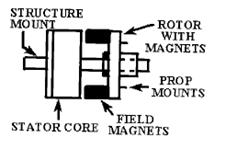Курсовая работа: Planning of mobile complete set for a rural wind generator
This investigation will only concentrate on assembling the generator part of the wind turbine system.
For the construction of the PM generator in this thesis two options were considered, the first was to collect readily available off-shelf materials to assemble a small generator. And the second was to convert an AC induction motor to a PM generator. Both options are discussed in this chapter.
6.2 Materials required to assemble a PM generator
The main idea is to build a portable generator that is easily assembled and constructed in the laboratory. The author first begins with highlighting all the materials that are needed in the construction of this generator. Figure 6.1 gives the schematic of how the generator will look like.

Figure 6.1 Basic wind generator design
From the generator illustrated above it is clear that the following materials will be required in the construction of the generator:
· Magnets
· Stator and rotor
· Rotor mounted on a rotating structure
· Structure mound
In the following sections the author will outline steps taken and the challenges faced in collecting these materials.
6.2.1 Magnets used in the generator
In the investigation of the performance of the generator, the author was to begin by designing the generator using standard commercial magnets, which were to be later substituted with recyclable magnets. The recyclable magnets are picked randomly in the dumpsites of Ga-Rampuru village.
Finding commercial magnets for this investigation was a major challenge since for this two-pole generator the author needed to purchase two NdFeb32 magnets, two Alnico5 magnets and two ceramic8 magnets.
6.2.2 Stator and rotor
The rotor rotates with the structure mount while the stator is fixed and mounted to a support structure. Since all these investigations were to be carried out under controlled laboratory conditions a drive and a frequency inverter which are readily available in the laboratory will be used to rotate the rotor at the desired speeds.
The drive will rotate the rotor and the induced voltage from the coils on the stator will be monitored by a voltmeter in the laboratory. Figure 6.2 illustrated this type of drive.
The size of the rotor in this thesis was constrained by the diameter of the recyclable speaker magnets. Therefore steel with this shape had to be found or cut to this shape. After finding the relevant steel, the cylindrical steel has to be drilled at the center.
6.3 Converting an induction motor into a PM generator
Due to the challenges faced in gathering the materials needed to assemble the generator the author then decided to find an alternative method to investigate the performance of the generator using recyclable magnets. A company called Magnetag that supplies motors and generators was approached and after some negotiations the company was willing to donate an AC induction motor to the author.
The idea was to convert this AC induction motor into a permanent magnet generator. This was going to be done by stripping the motor down and replacing the wound rotor with recyclable magnets. This looked like an attractive option since recyclable magnets with any shape can be used in the generator to explore its performance
The author was unable to complete investigating this option in detail. This is strongly recommended for further work most probably at MSc level.
6.4 Challenges faced during the construction of the PM generator
The main challenge in the construction of this wind generator was cost. For the laboratory investigation of the PM generator, a lot of materials, like the magnets and coils on the stator were found to be very expensive. This inadvertently gives more support for the use of recycled materials.
There was a lot of machining needed for this project, the rotor and the stator needed to be cut and shaped to the desired diameter and drilled in the centre to fit on the mount structure. Time was the major constrained since a lot of things were required to be done in the limited time given for this thesis.
However the framework of how to proceed in constructing and assembling the wind generator is already well laid out in this thesis.
Chapter 7. Conclusions
Based on the findings of the report, the following analyses and conclusions were drawn:
7.1 There is an urgent need of electricity
Due to the number of people living without electricity in rural South Africa it is clear that alternative means of supplying these areas is essential. According to ESKOM, all house holds will eventually be electrified, but the problem is, what is happening in the meantime? Where are children’s medicines being stored? Therefore this makes the electrification process extremely urgent.
7.2 Resource assessment
7.2.1Recyclable materials in the village
An extensive assessment on the rural village of Ga-Rampuru was conducted. There are plenty of recyclable materials including old milling machines that are not in use. These materials can be recycled to clean Ga-Rampuru village.
7.2.2 Rural artisans who can assemble the wind turbine